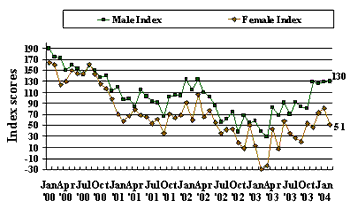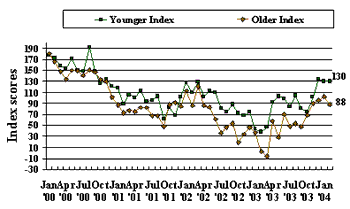GALLUP NEWS SERVICE
Investors expect a good investment climate in the months ahead, according to the Index of Investor Optimism -- a joint effort of UBS and The ÓĹĂŰ´«Ă˝Organization:
- Two out of three investors say the economy is currently enjoying a recovery or sustained economic expansion;
- Seven in 10 investors say now is a good time to invest -- the highest percentage since March 2002; and
- On average, investors expect a 12.4% rate of return on their portfolios over the next 12 months -- their highest expected return since March 2002.
Still, the Index of Investor Optimism declined to 97 in February from 108 in January. How can investor optimism decline even as the investment climate continues to improve? The answer seems to be that investor optimism differs greatly across various investor groups. While all investors are optimistic about the outlook for the markets, substantial investors are a lot more optimistic than other investors are.
Investor Optimism Declines
Following four consecutive monthly increases, the Index of Investor Optimism declined by 11 points in February. The overall Index now stands at 97 -- below its level of the past couple of months but at a comparatively high level for the past two years. Investor optimism is much higher than it was a year ago (9), when the country was preparing for war, and is just about where it was two years ago (92).
The Personal Dimension fell five points in February and now stands at 67. This is more than twice its level of a year ago (30) and about where it was two years ago (69).
The Economic Dimension fell six points in February -- on top of its five-point decline in January -- and now stands at 30. In spite of these declines, the current level of investor optimism about the economy contrasts sharply with the pessimism investors showed a year ago (-21) and exceeds investor optimism along this dimension two years ago (23).
| Index of Investor Optimism –
U.S. January 2000 – February 2004 |
 |
Optimism Among Substantial, Male, and Younger Investors Did Not Decline
Over the years, "substantial" investors (those having $100,000 or more of investable assets) have generally been more optimistic than "average" investors (those having at least $10,000 but less than $100,000 of investable assets). Currently, investor optimism among substantial investors is not only much higher than that among average investors but is also showing greater stability. In February, optimism among the less than 15% of the population that qualifies as substantial investors remained essentially unchanged; the Index among substantial investors went from 119 in January to 121 this month. In sharp contrast, the Index among average investors fell from 101 in January to 84 in February.
| Index of Investor Optimism – U.S. Average vs. Substantial Investors January 2000 – February 2004 |
 |
Similarly, investor optimism among men is not only much higher than that among women, but is also maintaining its strength. This month, optimism among male investors remained essentially unchanged; their Index went from 129 in January to 130 in February. The Index among female investors fell from 81 in January to 51 in February.
| Index of Investor Optimism – U.S. Male vs. Female Investors January 2000 – February 2004 |
 |
Investor optimism among those under age 40 shows a similar pattern when compared to that of older (40 and older) investors. In February, optimism among younger investors remained unchanged from its January reading of 130. At the same time, optimism among older investors fell from 102 in January to 88 in February.
| Index of Investor Optimism – U.S. Younger vs. Older Investors January 2000 – February 2004 |
 |
"Palpable Unease" About Jobs
Last Friday, Federal Reserve Board Chairman Alan Greenspan, speaking before the Greater Omaha Chamber of Commerce Annual Meeting, stated, "There is a palpable unease that businesses and jobs are being drained from the United States, with potentially adverse long-run implications for unemployment and the standard of living of the average American." He went on to say, "In the debate that has ensued, a large gulf is often perceived between the arguments of economists, who almost always point to the considerable benefits offered over the long term by exposure to free and open trade, and the obvious stress felt by those caught on the downside of turbulence created by that exposure. It is crucial that this gulf be bridged."
Investor optimism data for the past few months seem to suggest that this "gulf" has already been bridged on the part of substantial investors. As holders of large investment portfolios, they are enjoying the benefits of soaring productivity, surging corporate profits, and the Dow's nearing its all-time high. Evidently, many substantial investors see the connection between these benefits and both corporate outsourcing and globalization.
For other investors -- not to mention those who are not investors -- who are not benefiting significantly from the wealth-generating aspects of globalization, the "gulf" is far from being bridged. Nothing illustrates this better than the heated criticism received by the chairman of President Bush's Council of Economic Advisers for telling the nation that outsourcing is just another form of international trade.
Greenspan is right that this "gulf" needs to be bridged. And, as he suggested on Friday, if it is not, then popular support for significant import tariffs could create real economic harm. But economists need to recognize that the bridging effort cannot be a one-way process. While they can assume away issues such as outsourcing jobs overseas as "sunk costs," the investor optimism data suggest that both the impact on people's lives and the political fallout of this process cannot be ignored.
Survey Methods
Results for the Index of Investor Optimism -- U.S. are based on telephone interviews with a randomly selected U.S. sample of 863 adult investors, aged 18 and older, with at least $10,000 of investable assets, conducted Feb.1-15, 2004. For results based on this sample, one can say with 95% confidence that the maximum error attributable to sampling and other random effects is ±4 percentage points. In addition to sampling error, question wording and practical difficulties in conducting surveys can introduce error or bias into the findings of public opinion polls.
